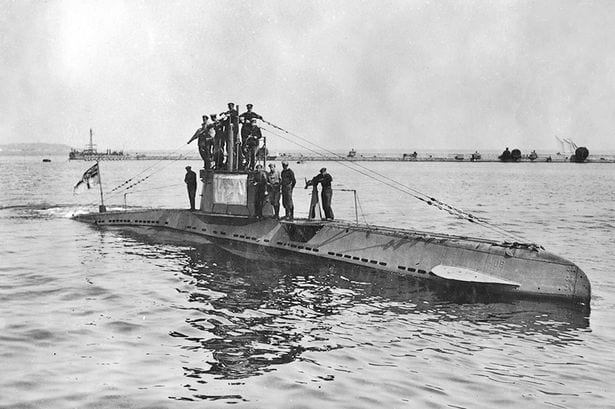After the occupation of France, England was alone in the battle of Europe. They were losing resources fast, and very quickly it seemed as if Germany could just wait the country to lose its resources. In order to keep England from forcing surrender, merchant boats from Canada and later the USA would transport resources to England from 1941 all the way to the end of the war in 1945. The Germans would counter this with submersibles called U-boats to sink these ships. This post is focusing on the conditions and downfall of the U-boats.
U-boats were really the beginning of a new battlefield. Now battles were happening on land, on the water, in the air, and under the water. The abbreviation of the word Unterseeboot, which literally translates to undersea boat. U-boats had been used since the First World War, but it wasn’t extremely effective until the Second World War, when it was used by the Nazi’s to control the Atlantic.
U-boats were essentially the assassins of the sea. They would pop up in the middle of a convoy, torpedo a ship, and then submerge to avoid retaliation from the convoy. This would happen thousands of times, as over 3600 Allied ships would be sunk in WWII by U-boats. This would effectively halt the transport of goods across the Atlantic for 2 years.
Even though U-boats were extremely effective, conditions within the U-boats were not good. A typical German U-boat would hold 35 men. Add torpedoes, engines, and all the equipment, and soon thats 35 men packed into a few small rooms. It wasn’t the greatest life. Real organic food was scarce, so most of the food came from cans. There was generally one washroom, for all 35 men. There were no showers, and the sailors only had one change of clothes. It already sounds like a living hell to live like this for one week. Well guess what, these sailors would live like this for over 6 months before seeing land.
Now we talk about the way U-boats were eradicated. In the Second World War Allied ships would use depth charges to attack submarines. A depth charge was basically a type of bomb used underwater. Before release the charge, it would be set to a certain depth. Once the charge reached that depth, it would detonate, either damaging the submarine or forcing it to travel deeper into the ocean. Slowly, the charges would be set to deeper depths, forcing the u-boat deeper. This would happen until the depth charges sunk the submarine, or the submarine reached a depth where it couldn’t handle the water pressure. This would basically cause the submarine to flood with water and then explode.

Imagine being a U-boat sailor in this situation. Water bursting through pipes, lights exploding, valves opening suddenly. It doesn’t sound like a very nice way to die. Unfortunately, this happened pretty often. Of the 1,100 U-boats the Germans produced, 632 were sunk at sea. Thats over 50% of all U-boats gone. Once the Allies had learned how U-boats were being used and deployed, it was very easy to pick them off. Come 1942, the War in the Atlantic had shifted to the Allies favour. U-boats had a tactic of sitting still underwater after attacking a convoy. This allowed the U-boat to achieve ultimate silence,. The allied convoy, who couldn’t hear the U-boat anymore, would move on, leaving the hidden U-boat to surface 30 minutes later. Once the Allies discovered this tactic, what they would do was have one destroyer move back and wait for the U-boat to surface. This eliminated any advantage U-boats had. The era of U-boat domination in the Atlantic had been halted.

I think we can credit the demise of U-boat crews to the design of U-boats. In order for the U-boat to be operational underwater, it would have to turn off its diesel engine and run on a small electric engine. This meant the U-boat would be extremely slow underwater, and could really only move at a moderate pace above water. U-boats were also produced at a very large scale, and Im sure quality was not the main focus when producing these submersibles. This could lead to faulty equipment, malfunctions, and a restricted amount of movement. When i say “restricted amount of movement” i am referring to the fact that U-boats were forced to repeat the same pattern while attacking, just by the nature of how the U-boat was made. Slow underwater, they were forced to sit in silence after attacking, and didn’t have an escape plan when the Allies caught on.
It is a sad idea, that these young men in their twenties were trapped in a flooding box hundred of meters underwater, but that is the nature of Nazi warfare. There have been plenty times where Hitler wasted troops, sometimes just for his own amusement. Ultimately it cost him the war. What if Hitler had been sane, would thousands of men be saved from this fate of drowning under the sea? I think that’s a question nobody can can answer. That being said, if you think you can answer, leave a comment down below.

There is a really interesting and disturbing short story about this idea of being trapped as a submariner. Also, the real story of the Kursk is heart breaking: https://www.popularmechanics.com/military/navy-ships/a23494010/kursk-submarine-disaster/
Have you ever been on a submarine?
Wow I had never heard of the Kursk before. That is a very sad story. I can’t imagine what was going through the minds of the survivors after the initial explosion.
I have been on a submarine before. There is an amazing exhibit at the Oregon Museum of Science and Industry of submarine USS Blueback. The submarine was designed for 85 men, but as I walked through it was hard to imagine 30 men living in such a cramped space. The dining area only sat 16!
Benjamin